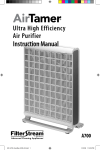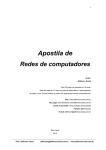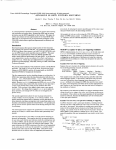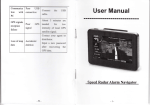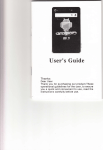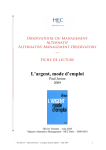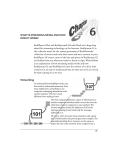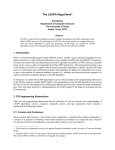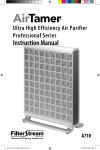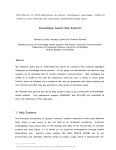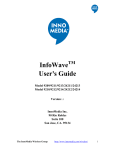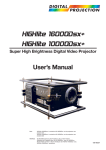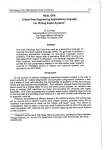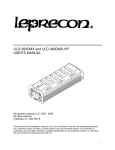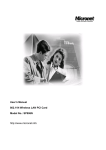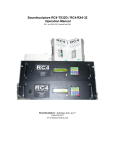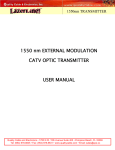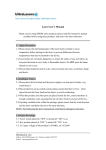Download pc_ieee_trans_consumer_elect_1995.
Transcript
Provided by the author(s) and NUI Galway in accordance with publisher policies. Please cite the published version when available. Title An Active-Node Fault Diagnosis System for CEBus Networks Author(s) Corcoran, Peter; Nolan, Paul J.; Humborg, Kenn; Lusted, Karl Publication Date 1995 Publication Information Lusted, K., Humborg, K., Nolan, P. J., & Corcoran, P. M. (1995). "An active-node fault diagnosis system for CEBus networks". "IEEE Transactions on Consumer Electronics", Vol. 41 (No. 3), pp. 884-889 Publisher Item record IEEE http://hdl.handle.net/10379/275 Downloaded 2015-12-17T23:38:45Z Some rights reserved. For more information, please see the item record link above. 884 IEEE Transactions on Consumer Electronics, Vol. 41, No. 3, AUGUST 1995 AN ACTIVE-NODE FAULT DIAGNOSIS SYSTEM FOR CEBUSNETWORKS Karl Lusted,’ Kenn Humborg,’ Paul J. Nolan,2and Peter M. Corcoran’ ’Dept. of Electronic Engineering, University College, Galway 2Dept. of Mechanical Engineering, University College, Galway Abstract The design and implementation of an active-node fault diagnosis system for CEBus networks is described. The system uses an IBM PC with a user-friendly GUI to provide statistical information on network traflic and messages. The PC is linked to an active CEBus node which monitors the network and can initiate testing sequences controlled by the PC. This consists of a CEBus node with a physical interface to the AC power-line [2]. This node is controlled by a dedicated microcontroller with modified protocol software to facilitate test and monitoring activities. This ‘active-node’is linked to an IBM PC which controls the analysis of network monitoring activities and presents data summaries and control functionality to the system User via a GUI interface. The fault diagnosis system overview is given in Figure 1. 1. Introduction The Consumer Electronic Bus (CEBus) is a multimedia LAN standard developed for home automation applications [l]. The CEBus standard is a subset of the OS1 seven-layer model. In particular it conforms with the OS1 model at the three lower protocol levels: physical, link and network layers [2]. The implementation of these lower layers is quite robust and a practical CEBus network is fault-tolerant with a low probability of communications errors propagating to the higher layers. Despite this robustness, communications errors will still impact on network performance generating increasing traffic, incomplete packets and excessive usage of IACK call-backs [3]. In worst case situations it is conceivable that a network may fail, or be rendered dysfunctional, by a single faulty node. Performance analysis and evaluations of the CEBus [4,5] do not allow for badly-behaved nodes which can have a noticeable effect on throughput and message delay for the entire network. In this paper we consider the design and implementation of a fault diagnosis system for practical CEBus networks. The implementation described in this paper is for the mains power-line medium, but can be adapted for any of the media supported by the CEBus standard. We begin with a summary of packet communications formats between the CEBus active-node and the PC, followed by an outline of the principle types of CEBus errors and how these can be detected. A description is then given of the fault diagnosis system. Manuscript received June 12, 1995 0098 3063/95 $04.00 ______________ r-Graphical User Interface Database r-! - 1 ______ --+ Message Transfer Element v - -.* Mod,/iedpmrocol\ 7 - A C Powerline Figure 1. CEBus Fault Diagnosis System Overview 2. CEBus Packet and Data Formats This section describes the communications interface between the modified CEBus modem and the PC used for the actual diagnosis of network fault conditions. This is important for two reasons: firstly, some errordetection is carried out in the hardware implementing the physical layer of the CEBus interface and this information can be trapped and passed on to the PC software by the CEBus active-node and, secondly, the packet formats described in this section provide our second level of error-check on the transmission integrity of the CEBus network. 1995 IEEE ___ 885 Lusted, et al.: An Active-Node Fault Diagnosis System for CEBus Networks 2.1 CEBus Modem to PC communications There are two principle forms of data transmitted from the modem to the PC: (i) Single characters indicating errors detected by the CEBus modem. These errors are generally physical layer errors or errors in node operation, e.g. packet collision on network, communications buffer full, etc. (ii) Received packets detected on the AC powerline medium. Received packets consist of standard CEBus DLL frames received over the network encapsulated with Start-of-Packet and End-of-Packet characters. These extra characters serve to distinguish the CEBus packets from the character-based communication of detected errors. The standard CEBus frame format using SE error detection is given in Figure 2. PRE Control DA D H C SA S H C PRE : Control : DA : DHC : SA : SHC : Information : Information Packet preamble Control field (packet type, priority, service class) Destination Address Destination House Code Source Address Source House Code Information field Figure 2: Normal MAC Frame Format 2.2 PC to CEBus Modem Communications In active mode, the fault diagnosis system transmits test packets over the AC powerline. These test packets are designed to test for a particular type of error suggested by analysis of received packets during passive mode. The PC sends DLL frames preceded by a Network Layer header, and any requests for Network Layer services from the Application Layer (diagnosis system). 3 Classification of CEBus Network Errors It is necessary to classify CEBus network errors in order to develop a fault diagnosis system to detect them. CEBus errors have been grouped according to protocol layer, the list is not complete, but does give an indication of the type of errors that can be expected to occur. 3.1 Errors Generated in the Physical Layer The Physical Layer is the lowest layer of the CEBus protocols. It is concerned with the physical transmission and reception of bits on the CEBus medium, i.e. the AC powerline. Errors occurring in the physical layer are not normally reported to higher CEBus layers, but the CEBus modem software has been modified to indicate the occurrence of such errors for the purposes of fault diagnosis. Elements of Layer System Management [2J techniques are used to pass information from the lower protocol layers to the Application Layer. Physical layer errors are useful for collecting network statistics, which can provide valuable information to the failure analysis software. Typical Physical Layer errors include packet collisions, loss of carrier, transmission aborted, etc. 3.2 Errors in the Data Link Layer The Data Link Layer is responsible for the correct transmission and reception of CEBus packets. The Data Link Layer handles acknowledge packets, retransmission of packets, ensuring correct Channel Access Method, etc. Errors occurring in the Data Link Layer are usually not as easy to detect as errors occurring in the Physical Layer. 3.2.1. Incorrect Channel Access Method All CEBus nodes must adhere to a set of rules for obtaining access to the Powerline medium. These rules, known as the Channel Access Method, stipulate certain delay times before attempting channel access after the last communication, deferral to nodes already communicating on the network, allowing time for ACK packets before attempting new communications, etc. Thus, most of these errors can be detected by examining the inter-packet timings sent from the CEBus Modem to PC. These inter-packet timings consist of the number of USTs (Unit Standard Times) elapsed since the last CEBus channel activity, and precede the packet information. Detectable errors include: (i) Insufficient delay time between packet transmissions. Generally, if inter-packet timing is less than I O USTs then the communicating node is not waiting long enough between communications [3]. (ii) Excessive delay before transmitting ACK packet. Any ACK packet should be transmitted not more than 6 USTs [3] after reception of a packet requiring an acknowledgement. This is to ensure that ACK packets are always sent before standard packet communications begin again. 886 IEEE Transactions on Consumer Electronics, Vol. 41, No. 3, AUGUST 1995 The fault diagnosis system must not only examine the inter-packet timing, but also the packet type to see if the Channel Access Method is being adhered to. The Channel Access Method also specifies additional delays for packet priority, packet queuing, and randomisation. By examining the inter-packet timings and the packet data containing priority information, etc., the fault diagnosis system can detect more subtle errors in the Channel Access Method. 3.2.2. Failure to send ACK packet If a CEBus node transmits a packet and the packet data indicates that an ACK packet is expected, then the next packet received should be an ACK packet from the receiving node. The fault diagnosis software must examine all packets to see if an ACK packet is requested, and then check the next packet to see if an ACK packet was sent. Failure to do so suggests that the receiving node is faulty and can be checked in active mode by the transmission of packets to the suspected faulty node. 3.2.3. Multiple transmission of the same packet If a CEBus node continually transmits the same packet to another CEBus node even though the original packet was received correctly, the transmitting node may be faulty. This error can only be detected by creating a database of all original packets on the CEBus network during the passive mode analysis. A new packet is added to this database only if it can not be found in the database already. Each time a match is found for a particular packet, a counter for that packet is incremented. Thus the excessive transmission of a particular packet can be detected. 3.3 Errors in the Network Layer The Network layer is primarily concerned with packet routing in a CEBus network which may consist of several different media linked through a series of Routers and Brouters. The fault diagnosis system outlined in this paper deals with errors on a single me-dium but may be extended to detect errors in the Network layer. 3.4 Errors in the Application Layer (CAL) Error detection in the Application Layer has not been implemented in the current version of the fault diagnosis software. This is principally because of the potential complexity of CAL constructs. However some preliminary studies have been undertaken and the framework of an interpretation and diagnosis system for CAL is described briefly. The Common Application Language (CAL) provides a framework through which CEBus devices may communicate with, and control objects on another CEBus device [ 6 ] . The CAL uses a particular syntax whereby every object on a CEBus device has a set of properties associated with it, known as Instance Variables (IVs). The values of these IVs completely define the object in question and they may be read only or readwrite. All CEBus devices can be represented by a collection of such Objects. Mistakes and errors in the CAL syntax of CEBus packets can be detected by a system which relies on a set of grammatical rules for CAL. It is also possible for devices to send CAL messages that refer to objects on a device that do not exist, refer to IVs within an object which do not exist, etc. The standard specifies that each node can be asked to supply details of its constituent objects. The system can thus build up an internal representation of the devices of the network [7]. The validity of CAL messages can be checked by using this information in the analysis stage. 4. The Active CEBus Node The “active” CEBus-node is controlled by a dedicated microcontroller with modified protocol software to facilitate test and monitoring activities. The Medium Access Control (MAC) sublayer of the data link layer has been modified to allow the system to receive and record all network packets. These captured packets are passed to the Application layer along with channel timings in Unit System Times (USTs). Network errors detectable by the lower layers of software in the CEBus node are also passed to the Application layer for storage to an integrated database. 4.1 Active Node Hardware This consists of three main functional subsystems: interface circuitry to the mains powerline; a spreadspectrum mains modem IC and a supervisory microcontroller. A small CEBus network was implemented using five CEBus mains modems. Three of the modems can be operated in standalone mode. In this mode, packet sequences can be programmed to repeat periodically and random packet generation is also supported. The remaining two nodes were connected to IBMcompatible PCs and controlled by software running on the PCs. One node was used to implement the fault diagnosis system. The other node was used to simulate faults by transmitting invalid packets and disobeying the channel access protocols. 887 Lusted, et al.: An Active-Node Fault Diagnosis System for CEBus Networks 4.2 Active Node Software The microcontroller subsystem implements the datalink and network layers of the CEBus protocols. For the present work they were modified to facilitate the requirements of the 'active' and 'passive' modes of the fault diagnosis system. The modifications allow the node to capture packets from all other nodes on the system when it is in passive mode. In active mode it can simulate another system node. Test packets can also be generated by the node to allow active testing of the network. This feature allows periodic or continuous testing of a suspect node on the network and would be particularly useful for the detection of intermittent fault conditions. A graphical user interface (GUI) was developed for the PC software. This gives the user access to all the available functionality of the system in an easy-tolearn and user-friendly manner. The main screen of this interface is shown in Figure 3. Plotting functions have also been incorporated into the software to produce graphs such as Figure 4. 5. Fault Diagnosis System Operation Initially the system simply 'listens in' on the CEBus network, recording all network events (packets and physical layer errors and signals) and their associated timings and storing this information to a database. The system then analyses the collected data in an attempt to detect faults or determine probable fault scenarios. The analysis engine produces a set of packet sequences designed to confirm or disprove its hypotheses and to collect additional data if required. After the analysis stage, the system transmits the test packets and records network events. The analysis stage is performed again to give an improved diagnosis. The process can be repeated as often as desired. The test sequences of packets transmitted over the network are re-configurable and extendible as further network faults are categorised and their test conditions identified. At present data for active test packet sequences is generated in two ways: (i) Pre-defined packet sequences can be defined in a data file which is loaded when the PC software starts up. (ii) Additional sequences can be manually generated while the program is running and saved to a data file for future use. Effectively, the user is performing part of the analysis function. It is envisaged, however, that the procedure will be automated to a greater degree. Improved intelligence in the diagnosis engine would allow it to generate its own test sequences from a set of primitives in much the same way as a human would. Using an expert system to implement the analysis engine provides a straightforward method of encoding the necessary rules and heuristics for this type of analysis. Figure 3: The User Interface. As our studies are still at a formative stage it is not yet clear how such a system could be best implemented to provide a practical balance of flexibility, transparency and extendibility. This must await more detailed studies on a range of CEBus networks, ideally covering the different physical media described in the CEBus standard [ 2 ] . ChannelAdvm/lrom 28/05/9521 4023l026/05/95 21 45 15 6T / 1 0 AA: n :Mnd c Errors d 6. Methodologies for Fault Diagnosis ~ Figure 4: Graph of network activity A basic analysis engine was developed using a readily available expert system. In general expert systems are classified as either data driven (pattern directed) or goal driven. The particular expert system used in this project is pattern driven in that it comprises: 0 working memory 888 IEEE Transactions on Consumer Electronics, Vol. 41, No. 3, AUGUST 1995 production memory (rules) an inference engine The expert system thus works by trying out rules (based on the current state of the working memory) using the inference engine and updating the working memory as rules are fired. This approach is most suitable for general monitoring and analysis of the CEBus traffic. In particular it is expected to be particularly appropriate in analysing the application layer, where there will be a very large number possible solutions involving various objects, instance variables ( W s ) and CAL language constructs. The alternative approach (diagnosis or backward search approach) can also be readily implemented. In this case the goal is placed in working memory and matched against the "actions" of the production rules. This strategy is generally more suitable for diagnosis applications where there is a small number of possible outcomes. The generality of system in implementing both forward and backward search (or a combination of both) and well as the ease with which heuristics can be included are important at this stage of development of the project. The data collected by the system is converted into a form suitable for input into the expert system. Each event is represented as a Working Memory Element ( W E ) . A sample of the WME file is shown in Figure 5. Each WME comprises a unique identifier for the event and various attributes of the event (such as time, event type, packet contents, etc.). (rec "no 570 "date 28-05-95 "time 21-43-00 "source 0 "destin 0 "ust-del 0 priate CAL instructions are added to the rule base. The inclusion of heuristics information and the intelligent application of the active mode also requires the expert system. The diagnosis implemented to date has used rules explicitly specified by engineering knowledge of the CEBus protocol and the likely faults. An alternative approach which may be necessary is to use rule induction from a large example set. This will be used to complement the rules deduced above. 7. Conclusions A working CEBus fault diagnosis system for the AC powerline medium has been developed. The system has been designed to monitor network traffic and perform a range of analyses for actual and incipient fault conditions. It provides a useful aid to the developers of CEBus devices and has the potential to be applied as a practical tool in the debugging of faulty CEBus networks. REFERENCES [I] Hofmann, J., "The Consumer Electronic Bus: An Integrated Multi-Media LAN for the Home", International Journal of Digital and Analog Communication Systems, Vol. 4, No. 2, Apr. 199 I , pp. 77-86, 199 1. [2] EIA Home Automation System (CEBus) Interim Standard IS-60. Vol. 1 , Parts 1,7.8, EIA, June 29, 1992. [3] EIA Home Automation System (CEBus) Interim Standard IS-60, Vol. 4, EIA, June 29, 1992. "mess P "type 00 "prev 569 "plist empty ) (rec "no 571 "date 28-05-95 "time 21-43-02 "source 3 "destin 2 "ust-del 0 "mess P "type 09 "prev 570 "plist 70 E7 OF F4 30 34 F5 FF FF FF FF ) (rec "no 572 ^date 28-05-95 "time 21-43-02 "source 0 "destin 0 "ust-del 0 "mess P "type 00 "prev 571 "plist empty ) Figure 5: Sample data with WME elements. Rules in the expert system comprise one or more condition elements (CEs) and actions. The CE's are the IF part of the rule and the actions are the THEN parts. The syntax is quite straightforward and is described in [8]. It should be strongly emphasised that the results presented so far could have been implemented algorithmically e.g. using a BASIC, C program or using the search facility in an available data base. The power of an expert system becomes clear when the rules for the underlying CEBus objects and the appro- [4] Pakkam, S.R. and Manikopoulos, C.N., "Performance Evaluation of the Consumer Electronic Bus", IEEE Trans. Consumer Electronics, Vol. 36. Nov. 1990. pp. 949-953. [ 5 ] Yang, J. and Manikopoulos, C.N. "Performance Comparisons of the CEBus with other Protocols" IEEE Trans. Consumer Electronics, Vol. 39, Nov. 1993. pp. 824-83 1. [6] EIA Home Automation System (CEBus) Interim Standard IS-60, Vol. 8. EIA. June 29. 1992. [7] Corcoran, P.M. and Lusted, K. "A Remote Electronic Object Emulation System for Home Bus Applications". IEEE Trans. Consumer Electronics, Vol. 40, Aug. 1994. pp. 405-410. [SI Forgy. C. L., OPS5 User's Manual, Technical Report CMU-CS-81-135, Department of Computer Science. Carnegie-Mellon University. Lusted, et al.: An Active-Node Fault Diagnosis System for CEBus Networks 889 Biographies Peter Corcoran received the BA1 (Electronic Engineering) and BA (Maths) degrees from Trinity College Dublin in 1984. He continued his studies at TCD and was awarded a Ph.D. in Electronic Engineering in 1987 for research work in the field of Dielectric Liquids. In 1986 he was appointed to a lectureship in Electronic Engineering at UCG. His research interests include microprocessor applications, environmental monitoring technologies, and automated testing of electronic components and equipment. He is a member of the IEEE. Paul J. Nolan is a Statutory Lecturer in Mechanical Engineering at University College, Galway. He received the BE degree from University College Dublin and the M.Eng and PhD degrees in electrical engineering from McMaster University in Ontario. His employment included work at Power Technologies Inc (Schenectady, NY). His research interests include computer simulation and control and application of AI in engineering. Karl Lusted received his BE degree in Electronics from University College Galway in 1992. He is presently studying for the degree of M.Eng.Sc at UCG. His research interests include microcontroller applications and communications network protocols. He is a member of I.E.I. and an associate member of I.E.E. Kenn Humborg received the BE degree in Electronic Engineering from University College, Galway in 1994. He is presently studying for an M.Eng.Sc degree at UCG. His research interests include computer networking and application of fault diagnosis methods in automatic test equipment.








